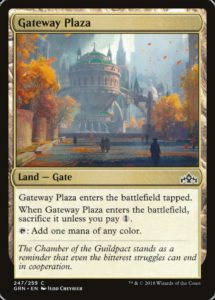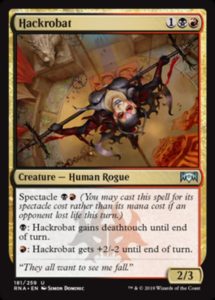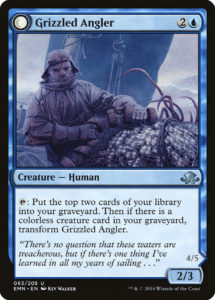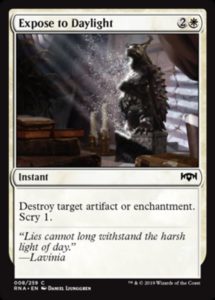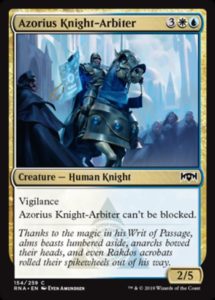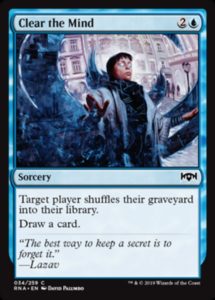Today, let’s talk about Sealed.
There are several (mostly) universal heuristics to Sealed. You want to play as many of your bombs as possible. You should accordingly expect to face more bombs than you would in Draft. Sealed decks tend to be slower, clunkier, and more ambitious with their mana bases. You’ll see fewer decks built around synergies and more around B.R.E.A.D. Some formats have a best color or worst, contorting the Sealed environment; you saw a lot of blue and red in Guilds of Ravnica and a lot less green. These rules of thumb are fairly well known and won’t be discussed today. Instead, let’s consider strategies specific to Ravnica Allegiance.
Lands Are Key
You’ve received your Sealed pool. You’ve verified its contents, organized cards by color, and peeked at your rares. Normally, most folks would start laying out each color’s curves or evaluating card quality. But in RNA, you should go straight for your lands.
You are guaranteed six guildgates, one in each pack. Every Gateway Plaza, shockland, foil guildgate, and Open the Gates beyond those six is a gift that will let you more easily stretch your colors and play better cards. Multicolor formats always have a variety of powerful multicolor commons and uncommons, so a strong mana base elevates your deck’s power level. Just as rares have a strong pull, encouraging you to build around them, so too should dual lands.
Ideally, your lands will be clustered in certain guilds or colors. For example, three Gruul Guildgates make it easy to play Gruul and splash blue or red cards, or to play Simic/Rakdos and splash red. Such a manabase also provides no help to a base Azorius or Orzhov deck, focusing your deckbuilding. Sometimes your duals will be clustered such that you have to decide between leaving your best cards in the sideboard or playing a clunky deck, but in general you’d rather have options in 3/5 guilds than the mediocre mana a diverse array of guildgates offers.
Lockets are much weaker fixing and generally shouldn’t be considered until later. They tend to be best at enabling a splash color rather than one of your main two or three, but I’ve had decks with enough off-color gates that I needed the main color fixing more (and my lockets were easier to crack).
Rakdos is risky
Aggro is usually weaker in Sealed, having a harder time finding the critical mass of good, cheap creatures and interaction. Multicolor formats hamstring aggro by forcing it to rely upon color-committing creatures like Wojek Halberdiers and Truefire Captain.
Rakdos is much weaker than Boros was. It arguably has the weakest mechanic in the set, since Riot and Afterlife are all upside and require no setup or mana investment, Simic creatures are reasonably costed even before Adapting, and Addendum cards provide additional choices. On the other hand, Spectacle cards only function if you’re already in good position or are spending resources (or contorting you deck with weaker cards) to turn them on.
The second failing of Rakdos is its card quality. Footlight Fiend, Rakdos Roustabout, and Rafter Demon compare very unfavorably to Senate Griffin, Frenzied Arynx, Aeromunculus, and Imperious Oligarch. Get the Point provides less advantage and tempo than Savage Smash or Applied Biomancy and cost more than both Lawmage’s Binding and Final Payment. Rakdos commons are weaker than their contemporaries.
All this said, you probably don’t want to register a Rakdos deck unless you have a bevy of powerful uncommons and rares. That said, it’s worth sleeving one up anyway sometimes.
The Bait and Switch
When my deck is awesome, I’m happy to sleeve up some potential sideboard cards and call it a day. Sometimes, I’m unsure of which deck to choose between some close options, or which color to splash, so I make some sideboard plans. And sometimes, my pool is just bad. It can’t go card-for-card with a reasonably powerful deck. That’s when it’s time for the bait and switch.
If you can build two decks that operate completely differently from each other, you might be able to beat substantially better pools than yours. If you main a Rakdos hyperaggro deck, a controlling opponent is going to sideboard out a lot of their clunky, expensive cards and card advantage. All they need to do is survive and their superior card quality will carry the day. That’s when you switch to your mediocre control deck with lots of expensive cards. When this works, you convince your opponent to show up with a knife to a gun fight, or do the opposite and go for their throat while they’re still loading their musket. This is the strategy that earned me my first day two at a Limited GP back in 2015.
This strategy is risky. It doesn’t always work, and it’s extra hard in RNA where Rakdos is underwhelming. But it’s good to know this strategy is a strong counter to the arms-race of control and midrange decks that always pushes higher up the curve.
Know your Expected Metagame
One always wants to perform well, but not all pools are created equally. The better you do, the higher the quality of decks (and players) you’ll face. You’ll see more mega-bombs like Ethereal Absolution and Skarrgan Hellkite and engines like High Alert and Angelic Exaltation. If your deck is really good, you might consider main-decking a card like Expose to Daylight so you’re pre-boarded against all the other great decks in the X-0 bracket. You might leave some of your anti-aggro cards out of the main deck, since Rakdos has issues and Gruul midrange and Esper flying creatures are the more likely threats.
Check for Gruul and Esper
My group’s testing found that Gruul is likely the best guild. It has ridiculously powerful commons like Savage Stomp and Frenzied Arynx, an absolutely bonkers uncommon in Rhythm of the Wild, and can shore up its creatures with Simic cards or removal with black. Even Rubblebelt Runner is big compared to what the other colors can field.
Esper is the next place to look. It has the best and most removal, the best defenses and flying creatures, the best bomb in Ethereal Absolution, the best card advantage, and it doesn’t need to dip into Rakdos. Don’t be afraid to build a basically blue-black deck that splashes white; Chillbringer, blue fliers, and black uncommons make a solid shell for a deck even though Dimir isn’t in the set.
Simic isn’t a bad guild by any stretch, but its creatures are slower than Gruul’s and its interaction is weaker than Esper’s. Simic is probably best suited to play support in Temur or Bant decks, rather than be the main guild in Sealed. And then there’s Rakdos. He knows what he did to his guild.
And there you go, the tips and tricks specific to Ravnica Allegiance (but also applicable to most multicolor formats). I’m quite proud of all the testing my friends accomplished in such a short span of time leading into MagicFest New Jersey. This knowledge unfortunately has a bit less utility than it would normally have—Sealed is on Arena for the present moment, will be on Magic Online for months, and will be featured at a few more GPs, but that’s it. There are no local tournaments to prepare for, since PPTQs have been retired and the new PTQ system has neither gone into effect nor been explained. I’ll likely only play RNA Sealed one more time, at MagicFest Cleveland, and then that’ll be it until War of the Spark releases sometime in April (and given the event schedule, there might not be a release weekend Limited GP).
I certainly prefer drafting to playing Sealed, but the dearth of competitive Limited opportunities makes playing both more difficult to come by. This situation is a consequence of Magic’s great success with Arena and the growing pains of a new, unknown system—things are going to get better and information is going to come out, we’re just in the awkward transitional period.
And, as always, thanks for reading.
—Zachary Barash is a New York City-based game designer and the commissioner of Team Draft League. He designs for Kingdom Death: Monster, has a Game Design MFA from the NYU Game Center, and does freelance game design. When the stars align, he streams Magic.
His favorite card of the month is Growth Spiral. Explore is one of his favorite designs ever, and this is not only the same card, but it avoids the complexities of playing extra lands. Also, have you seen that artwork by Seb McKinnon?

